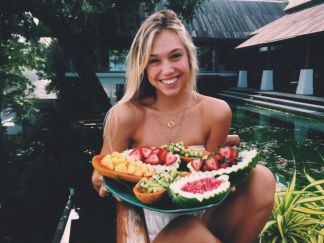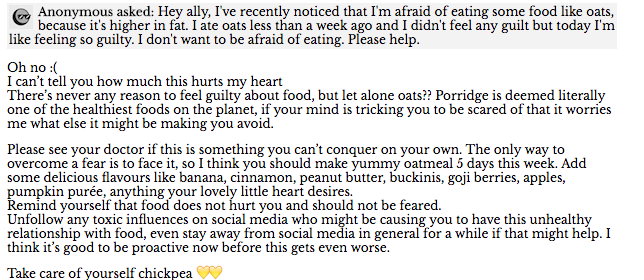I went vegan two years ago after discovering that the persistent stomach aches I had been experiencing all of my life were due to a severe dairy sensitivity that no testing for lactose-intolerance could seem to locate. The minute I stopped eating the goat cheese and chocolate milk I had savored all my life, the clouds parted, the sky cleared, the sun shone, and I no longer spent inordinate amounts of time with the Porcelain Gods (TMI?).

But the longer I spent exploring the internet for vegan recipes to feed both a hungry tummy and a curious mind, the more I began to see a disconcerting trend among the vegans of the internet. Skinny white girls with smoothie bowls had taken the once ethics-oriented community by storm.
There are a lot of benefits associated with going vegan. Your carbon footprint can be reduced by almost half when you switch to a diet without meat and dairy. You lower your risk of heart disease, multiple forms of cancer, and diabetes. Reduced symptoms of allergies , PMS, and migraines have even been reported. Lastly, you are reducing your negative impact on the lives of the creatures living with us on this earth, if we want to get all kumbaya up in this blog post. And of course, when you switch to a diet of mostly whole grains, fruits and vegetables, you lose weight just from lack of cholesterol and high fat foods. Completely unintentionally, I guesstimate that I lost about five pounds in the first few months after I went vegan, which was never a goal but interesting to observe.

Unfortunately, the true benefits of a vegan diet, that of overall health, lowered environmental impact, and increased ethical consumption, have been overshadowed by its benefits for weight loss. I think some of us may remember the controversy of Essena O’Niell, an Australian Instagram star and outspoken vegan who eventually, for lack of a better term, broke down due to the pressures associated with the body image she forced herself to maintain for her social media fanbase. She eventually went back through all of her Instagram photos, describing the real story behind the hugely popular images that young girls would look to for inspiration.
I follow a girl on Tumblr named Ally Sheehan who posts delectable vegan recipes but every day contends with a flood of messages from girls as young as 12 and 13 worrying about whether the piece of cheese that they ate that morning might “make them fat”, or if the bit of chicken they accidentally had in their soup might make them gain weight. Or Bonny Rebecca (featured image), a big name in the vegan community, whose Instagram has an impressive amount of photos of her holding beautifully orchestrated vegan foods in such a way that you can see her flat stomach and thigh gap. Clearly, there has been a disconnect between the actual reasoning behind this movement and its most avid followers.

Veganism has become a grey area of eating disorders and false body positivity, in which appetite can be left uncontrolled but nevertheless restricted and the end goal is the now “quintessential” vegan body, white and “fat-free”. Susan Bordo describes the condition of anorexia nervosa as a “punishment” of the female body’s desires and appetites (Bordo 8). So what can we make of veganism?
And what can we make of the fact that the bodies posing in these popular photos are most often white? Numerous cultures are vegan to begin with, such as those who follow Hinduism, Buddhism, and Jainism. Eating an affordable, vegan diet is surprisingly easy when one buys in bulk, shops seasonally, and avoids the popular health foods toted by the vegan community (most often appropriated from another culture’s staple crop coughquinoacough) and has been shown to actually save

families money. Therefore, there is no aspect of veganism that should inherently exclude anyone from joining in, for economic reasons or otherwise. However the dominant narrative among the popularized vegan community, that of skinny white girls holding watermelons and smoothie bowls against a backdrop of their flat stomachs, creates a space that excludes both people of color and vegans of differing body shapes (of which there are numerous), leaving their voices conspicuously absent and ignoring the real ethical issues that veganism addresses.
I am just now wrapping my head around the true depth of the complexities involved in popular vegan culture and the inequalities and body normativity it promotes. As someone who found this way of living out of desperation for freedom from endless stomach aches, I am fascinated by the discourse that can be created by studying this community. I am very eager for your thoughts on this issue, and submit this blog post as an open question to the class: So what is the deal with this new, popularized veganism?
Sources:
Bordo, Susan. “Unbearable Weight: Feminism, Western Culture, and the Body.” University of California Press. 1993.
57 Health Benefits of Going Vegan. The Nursing School Catalogue.


Your points about erasure in the mainstream vegan and animal rights movement are exactly why I haven’t taken veganism more seriously, despite having persistent stomach aches that I presume are like the ones you had. What we have here is a serious case of white veganism, mired in aesthetics, white supremacy, and colonialism.
The conventionally beautiful white models at the forefront of a vegan movement are being equated with innocence, health, and progressiveness. Anything that is remotely different is considered ugly, barbaric, and backwards. Add onto that the decontextualization and subsequent appropriation of various cultural foods (for example, Bosh on Facebook has made some whack vegan renditions of South Asian and Middle Eastern foods), and we have Bonny Rebecca holding dragon fruit as if she were an angel sent from heaven here to spread the good word.
I found a great paper called “Decolonize Your Diet”: http://escholarship.org/uc/item/7wb1d2t6#page-4. The author explains how the Mexican staple diet is much more variant and healthy than the Standard American Diet, and explains how cooking a pot of beans can be a revolutionary act. The author says, “Cooking a pot of beans allows you to love and nurture your friends and family with life sustaining ancestral food while rejecting fast food and processed non-food-products” (Esquibel and Calvo, 3). This was such a great piece and reminded me of how I tried to cook vegan last summer and found it much easier to cook using ingredients and recipes from my own culture. The vision of watermelons and smoothie bowls that are oft represented have no cultural or gustatory appeal to me. That said, I’ve found some awesome vegan women of color (MommyTang on Youtube, the website Vegan Voices of Color) who’ve introduced new images and recipes to me, and I think the rise of these systemic disruptors will slowly change the way people see veganism in society.
1. “Dismantling White Veganism.” Vegan Voices of Color. Accessed May 20, 2017. https://veganvoicesofcolor.org/2017/01/09/dismantling-white-veganism.
2. Esquibel, Catriona Rueda, and Luz Calvo. “Decolonize Your Diet.” nineteen sixty nine: an ethnic studies journal 2 (2013): 1-5.
LikeLike
Trigger warning: eating disorders
When I was in high school, I went on a vegan diet for a short amount of time to help me feel as though I was living my life more ethically, but also because I was interested in losing weight, and my experiences reading about veganism on the internet had demonstrated, like you share above, that these are often tied. I think another aspect of this is something else I have seen, which is that oftentimes, people with eating disorders will say that they are vegan so that they have an excuse to not eat at public events when food is offered. I have noticed this among more than one of my friends with severe eating disorders, and this again strengthens the connection between veganism and thinness, but also the tie between veganism and eating disorders.
LikeLiked by 1 person
I am particularly interested in the following comment: “Eating an affordable, vegan diet is surprisingly easy when one buys in bulk, shops seasonally, and avoids the popular health foods toted by the vegan community (most often appropriated from another culture’s staple crop cough quinoa cough) and has been shown to actually save families money.”
Speaking from experience, I am frankly not convinced that eating vegan would be cheaper. First, the article mentions vegetarianism, not veganism (the website says Veganism isn’t a word), as the cheaper option.
Secondly, I am concerned about the accessibility of bulk foods, shopping seasoning, and avoiding popular options. As someone from a rural portion of New Mexico, where towns are 20 miles from my house, it is not feasible to buy bulk foods at the handful of stores that provide vegetables that are obnoxiously more expensive than say spaghetti. I can buy several boxes for $3.50, which is the price of a head of lettuce. The head of lettuce won’t feed me for a week, but the pasta will.
They also aren’t fresh or quality vegetables. If I want those, I have to drive even further to the far edge of town inhabited by wealthier white folks (we call that place Cids). Then, the food prices spike even more.
One of my friends was vegan for a bit, while working a near minimum wage job and she simply could not afford continuing to be vegan.
Here’s a few articles on accessibility:
1. Darmon N, Drewnowski A. “Does social class predict diet quality?” Am J Clin Nutr. 2008.1107–1117.
2. Kant AK, Graubard BI. Secular trends in the association of socio-economic position with self-reported dietary attributes and biomarkers in the US population: National Health and Nutrition Examination Survey (NHANES).
Thirdly, I want to address the morality behind vegan diets. This statement goes unspoken, but vegetarian/ vegan diets are not guilt free. Farmworkers are taken advantage of by capitalist institutions. This occurs in terms of pay, with violence, threats of deportation, and their erasure from these discourses.
LikeLike
As an athlete, one of the biggest problems I have always faced is making sure to eat the right foods before and after a workout. When I played club volleyball, we were asked to follow a strict diet prior to large qualifiers. When we went on trips, we were only allowed to order certain foods on the menu. A girl on our team was trying to transition to a vegan diet, but was struggling because she wasn’t properly eating enough to restore all the calories she lost during our intense practices. Thus, while being a vegan can be aesthetically pleasing to some, or help to clear up some issues with other foods (such as dairy), it seems that in a lot of instances, it can become a hindrance to transition to a vegan diet. For example, research has not been able to prove that being a vegan does not necessarily affect an athlete’s ability to perform; however, it has shown that creatine and vitamin B12, nutrients that can only come from meat, are low in athletes who are vegan. At the same time, people must be willing to dedicate time and energy to making sure that all of their meals will give them enough nutrients and vitamins. Like I stated before, my friend did not acquire the proper amount of nutrients to sustain a healthy life; she passed out at a volleyball practice once because she had not been eating enough nutrients to rebuild her muscles and keep her energy level up during workouts.
Another point: While I agree with Raul that being a vegan most likely does not save money, I would like to counter that point by saying it might be easier for families who live in big cities (like me) to transition to a vegan diet. I realize that Raul’s experience is different than mine as he lives in a rural part of New Mexico. However, at the same time, for a family living in Chicago, where Costco, Whole Foods, Trader Joes, and Sam’s Club are extremely accessible, buying in bulks is much more attainable. Therefore, a vegan diet seems a lot more achievable in this instance.
LikeLike
Similar to Wanchen’s first comment, I had not taken people that transition to vegan that seriously because it has become the newest trend. Similarly, I had thought of vegan as a way people can use an excuse to diet but seem healthy and is still acceptable. Another trend that I thought of this way is celiac or gluten free. When I played tennis in high school, my coach had gone gluten free and said it was the best decision of his life. I had thought it was a choice to go gluten free; however, the actual dietary constraints of celiac is very painful and can result in similar pains to lactose intolerant. As in Belle’s experience, there are people who are struggling to find a diet that works for their body so that they are not having painful experiences. There is this fine line between being healthy and dieting and I think this article illuminates this issue. It seems like more studies state that it is not just working out, it is healthy eating as well for a person to lose weight. Just as Belle puts it, “I am just now wrapping my head around the true depth of the complexities involved in popular vegan culture and the inequalities and body normativity it promotes. As someone who found this way of living out of desperation for freedom from endless stomach aches, I am fascinated by the discourse that can be created by studying this community.” Who knows what the next trend will be.
LikeLike
As Wanchen mentioned, “The conventionally beautiful white models at the forefront of a vegan movement are being equated with innocence, health, and progressiveness. Anything that is remotely different is considered ugly, barbaric, and backwards.” I would like to add to this comment that not only are the conventionally attractive white models equated with innocence but they are actively participating in, performing, and constructing innocence. I follow a few vegan instagrammers (all college-aged women from Australia), and almost every post I’ve seen overemphasizes how their meals are “cruelty-free” (sometimes in all caps) and contributing to a peaceful coexistence with other life forms on this earth. This reminds me of Christina Fallin’s apology, asking to be excused for innocently appreciating/adorning herself with a Native American headdress. Similarly, when white vegan instagrammers advertise their own innocence, they attempt to erase the negative contributions of unrealistic beauty standards and the lack of representation of body types and people of color in the community, as well as ignoring the complexities surrounding the ethics of veganism and issues of appropriation. As someone said at the end of one of our classes, “You can’t do anything ethically!” Veganism may be better for the environment, but that doesn’t mean it’s a glamorous, perfect solution to injustice, even if instagram makes it seem like one.
LikeLike